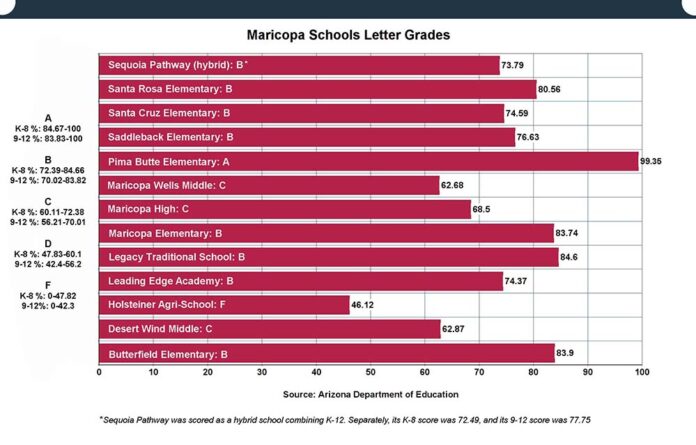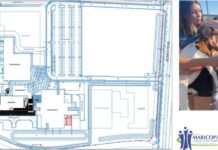[quote_box_right]A Excellent
B Highly performing
C Performing
D Minimally performing
F Failing[/quote_box_right]When the accounting was done for last school year, Maricopa had moved from having three A-rated schools to one A-rated school. But other schools were happy to see growth.
Fourteen schools in Maricopa were assessed by the Arizona Department of Education for the 2018-19 school year. Nine of them are in Maricopa Unified School District while the others are charter schools. The elementary and secondary schools at Sequoia Pathway were looked as a hybrid for a combined score, but results were also given individually.
K-8 and high school have slightly different measuring tools and different ranges for letter grades, but both have much of the scoring weight in student growth. Student growth is measured in proficiency and subgroup improvement. “Subgroups” are determined by economically disadvantaged, special education and other factors.
Pima Butte Elementary School, an A school last year, excelled by earning 1.5 points more. That gave the MUSD school a percentage of 99.35, the highest in Pinal County. A dearth of English Language Learners made the school eligible for only 90 points rather than 100.
“Pima Butte Elementary School has a smaller ELL population than a number of our elementary sites and as a result that portion of the state’s school letter grade calculation is not a factor to Pima Butte’s overall score and rating,” Principal Randy Lazar said.
When a school already rates “excellent,” showing even more growth can be difficult. But Pima Butte found a way to squeeze in the extra and increase its percentage.
“Under the Acceleration/Readiness section, we earned a couple more points in 2019,” Lazar said. “This helped raise our overall points.”
Among Pinal County schools, 65 percent earned a C-rating or lower.
High schools benefited from better reporting in the way the Department of Education scored the College and Career Readiness Indicators category. Maricopa High, again C-rated, moved very close to a B based on CCRI while Sequoia Pathway jumped into the B category as its CCRI points grew from 11.8 to 18.6.
“2018 was a baseline year for all of our schools, and several points were lost as we were determining the process for data gathering and reporting,” said Mark Plitzuweit, CEO of Edkey Inc., the parent company for Pathway. “Some of our principals reported more accurate information for 2018 than others. 2019 brought the focus on maximizing those points for all of our Edkey Inc. secondary schools.”
He said the result of “judicious” data gathering across the Edkey organization resulting in important CCRI growth.
“We expect these results to be stable in the years to come,” Plitzuweit said.
Though Pathway’s secondary school moved from 69.77 in 2018 to 77.75 in 2019, there were several staffing changes after the school year, including around 10 faculty resignations and terminations during the first semester of this year, with several posts filled by long-term substitutes. The impact on the next assessments is guesswork.
Noting MHS scored 68.5 and needed 70.2 for a B, MUSD Governing Board member Patti Coutré said during a November meeting, “The smallest amount of points can make a big difference… Even though they’re still a C, they’ve significantly increased every year for the last three years. So, they’re making progress. That’s always good to see.”
MUSD’s two middle schools, however, have low C ratings. Desert Wind dropped from 66.8 to 62.87 while Maricopa Wells had only a fraction of a point difference in its results.
MUSD’s Butterfield Elementary, which had jumped from a C to an A last year, lost some growth points to score a high B. Legacy Traditional School, a charter usually posting an A, had a similar fate as a decline in growth points left it with a high B rating. Leading Edge Academy, also a charter, last year was less than a point from an A but this year moved to a low B.
Saddleback Elementary gained growth points and went from being MUSD’s only C-rated elementary to earning a solid B rating.
Meanwhile, the charter school Holsteiner Agricultural School saw all its numbers tumble to fall from a C to an F. According to the Arizona State Board for Charter Schools, Holsteiner dropped its charter because of low enrollment.
School letter grade quantitative measurements are a mix of federal and state requirements. Schools are assessed on their proficiency and growth in English language arts and math, the proficiency and growth of ELL students, graduation rates, absenteeism, growth of subgroups and results of ACT or SAT, “or earning an industry credential, certificate or license.”
Dennis Koch, director of Assessment Technology at MUSD, reminded board members the district has a goal of “being a highly performing district with school letter grades of B and higher.”

This story appears in the January issue of InMaricopa.
















![Elena Trails releases home renderings An image of one of 56 elevation renderings submitted to Maricopa's planning department for the Elena Trails subdivison. The developer plans to construct 14 different floor plans, with four elevation styles per plan. [City of Maricopa]](https://www.inmaricopa.com/wp-content/uploads/2024/04/city-041724-elena-trails-rendering-100x70.jpg)

![Affordable apartments planned near ‘Restaurant Row’ A blue square highlights the area of the proposed affordable housing development and "Restaurant Row" sitting south of city hall and the Maricopa Police Department. Preliminary architectural drawings were not yet available. [City of Maricopa]](https://www.inmaricopa.com/wp-content/uploads/2024/04/041724-affordable-housing-project-restaurant-row-100x70.jpg)